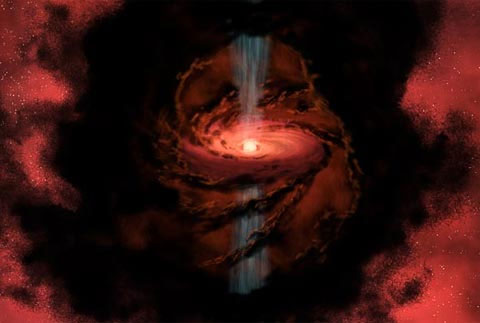Spot the star shooting 'water bullets' in the universe
New astronomers discovered a young, sun-like star lying 750 light-years away from our earth, with taps that fired water bullets with lightning speed to the surrounding space.
The findings suggest that protostars may be sowing water seeds in the universe. These star embryos shoot materials from their north and south poles in the process of development thanks to gas dust moving around into giant disks.

A star is born: Swirls of dust, gas fall in, start the hose to shoot materials
at the poles (shown in green in this illustration). Photo: NASA.
National Geographic magazine quoted Lars Kristensen, a postdoctoral astronomer at the University of Leiden in the Netherlands and the head of the new study, saying: " If we visualize these taps as giant tubes and bullets like bullets, the number of 'water bullets' shot out is 100 million times higher than the flow of water across the Amazon River every second. We are talking about speeds of up to 200,000. km / hour, about 80 times faster than bullets fired from a machine gun ".
Located in the northern constellation Perseus , the new stellar money is defined no more than a hundred thousand years old and is still enveloped in a large cloud of dust and gas that produced it.
Using the European Space Agency's (ESA) Herschel space telescope , researchers were able to see through the cloud and detect light signals on hydrogen and oxygen atoms (combined to form water) move on and around the star. After tracing the paths of these atoms, the team concluded: water forms on the star, where the temperature is about a few thousand degrees centigrade.
However, once the water droplets penetrate the gas nozzle, the temperature of 100,000 degrees Celsius causes the water to explode back into gas. Once hot gas encounters much cooler surrounding materials, at a distance of 5,000 times from the sun to the earth, they slow down, forming where the cold air rapidly, condensed and transformed into water.
What is really interesting about the above finding is, this seems to be a stage of the star going through, which can help clarify the earliest stages of our sun formation as well as the role of water. in this process.
Like a sprinkler system in the sky, the newly discovered star may be enriching the interstellar environment - thin layers of gas floating in the gap between stars. And because hydrogen and oxygen in the water are the two main components of star disks, the sprinklers of such stellar can facilitate the later development of stars.
- What horrible thing will happen when a body is hit by a bullet?
- Spot the first star of the universe
- The star is nearly 2,000 times bigger than the Sun, lighter than water
- The most 'weird' bullets in world gun history
- The horrifying weapon knows 'tearing up' human flesh
- America wants to develop bullets that, when falling to the ground, will grow into trees
- Video: Being shot from a distance of 2m from the gun is still safe if you stand in the water
- Super robot 4 tons releases bullets when the owner laughs
- The 'dying' of the largest star in the universe
- Don't joke, shooting just natural can kill others
- Life is like a movie: If it is shot, is it safe to dive into the water?
- Discover the most 'senior' star in the universe
 Van Allen's belt and evidence that the Apollo 11 mission to the Moon was myth
Van Allen's belt and evidence that the Apollo 11 mission to the Moon was myth The levels of civilization in the universe (Kardashev scale)
The levels of civilization in the universe (Kardashev scale) Today Mars, the sun and the Earth are aligned
Today Mars, the sun and the Earth are aligned The Amazon owner announced a secret plan to build a space base for thousands of people
The Amazon owner announced a secret plan to build a space base for thousands of people